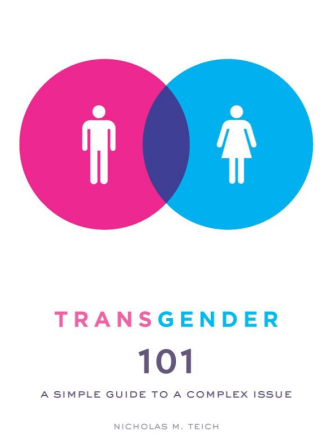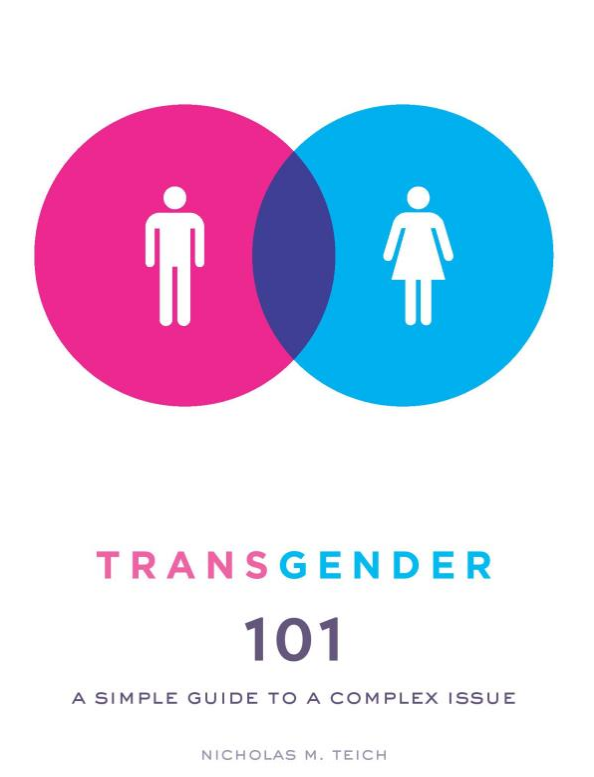 Transgender 101: A Simple Guide to a Complex Issue
Transgender 101: A Simple Guide to a Complex Issue
Nicholas M. Teich
Columbia University Press, 2012
168 Pages
By Gail Bush
A full 82 percent of trans students report feeling unsafe at school, according to Nicholas Teich in this “Simple Guide.” Gender identity is reported to be solidified as early as age 6. When adults fill out applications or participate in the census we check a box, male or female. As the author suggests, “Maybe the next time you run across a form that asks if you are male or female, you will think about the absurdity of the question.”
Teich’s title for his primer does evoke basic comprehension. The author’s clear and accessible writing style invites understanding from a wide audience. In his Huffington Post blog from April 2012, Teich explained, “When writing the book, I thought about the following: if you were sitting in a room with me, and I was explaining what ‘transgender’ means in the simplest terms possible, what would I say?”
Representation as the T in the now well-known acronym LGBT has its pros and cons. While it helps to bring the transgender community to the forefront of diversity discussions, it folds the issue into sexual orientation and much is lost or misunderstood somewhere in the translation. Reading this guide, however, confirms that there is absolutely nothing simple about this critically important and complex issue. Teich explains associated aspects of vernacular, grammar, biology, and sociology. He offers historical background that provides a foundation for the discussion of the medical versus mental health debate. And still, for the most compassionate of those who serve all youth either directly or through policymaking, this “simple” guide provides a lens to better view a unique facet of diversity within society that demands our attention.
For both the novice and the expert, Teich has vast insights to share. The concepts around gender identity versus gender expression, and the vocabulary regarding assignment at birth rather than affirmation alone, take careful reading to begin to understand the fundamentals of transgenderism. The expert who is engaged with the transmen and transwomen who has background and experience will appreciate the full treatment of the significance of the declassification of Gender Identification Disorder to Gender Dysphoria in the fifth edition of the American Psychiatric Association’s Diagnostic and Statistical Manual of Mental Disorders. (“Transgender 101” was published in 2012 but presumes the 2013 changes.) The book discusses several analytical perspectives regarding the medical versus the mental health qualification of transgender issues, not the least of which are ramifications in insurance coverage of medical treatment, including psychological or psychiatric therapy, transitioning hormone therapy and surgery.
Teich is a licensed social worker and doctoral candidate in social policy at Brandeis University who founded and directs Camp Aranu’tiq, an overnight camp for transgender youth. He recognizes that words matter deeply and carefully distinguishes between the substance of sexuality and gender. These are concepts that professionals, friends and family must continue to come to understand and then accept in order to truly believe what Dr. Harry Benjamin, the father of transgenderism and author of “The Transsexual Phenomenon” wrote to young people in 1966: “You have your whole life ahead of you. Something can and will be done for you. Just be patient and eventually you will lead a happier life than you do now.”
Teich is cogent in his message that while the many vocabulary terms may seem distinctive and appropriate, it is the determination of the persons themselves who define their pronouns, history and future. Ponder for a moment the multitude of terms and concepts: sex as male/female versus internal sensory = man/woman versus external representation = masculine/feminine. Beyond these distinctions is the concept of the self as transcendent from this binary approach. Living between and/or across with elements of identity and expression includes a broad spectrum of variations of translife such as intersex, gender queer or gender non-conforming. One person’s pejorative label may be another person’s preferred descriptor.
“Transgender 101: A Simple Guide to a Complex Issue” is highly recommended reading as a user-friendly introduction. In addition to the author’s text, Teich offers a rich back matter that includes a basic glossary, chapter notes, authoritative resources, bibliography and index.
If you’ve read a recent youth-services related book and want to review it, email Ryan Schill at rschill@youthtoday.org.


























